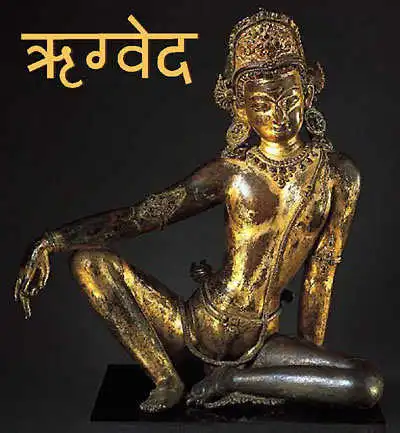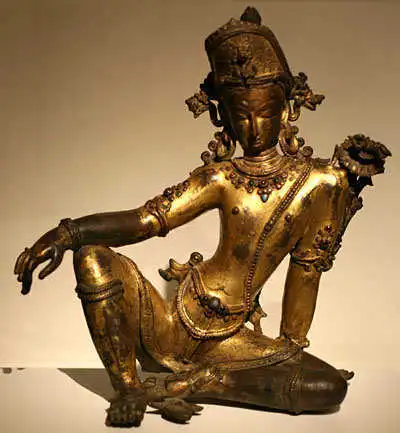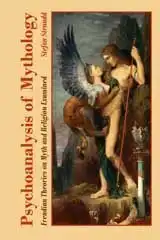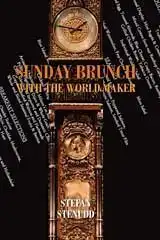
The Creation in Rig Veda 10:129Ralph T. H. Griffith's Translation
Ralph T. H. Griffith's Version of Rig Veda 10:129In 1889, just one year after the release of the last volume of the first complete translation of the Rig Veda by H. H. Wilson, another one was published. It was done by a fellow British indologist, Ralph T. H. Griffith.
Ralph T. H. Griffith (1826-1906) translated several of the Vedic scriptures, as well as other ancient Sanskrit texts. He based his Rig Veda translation on the Max Müller Sanskrit edition (Rig-Veda-Samhita : The Sacred Hymns of the Brahman, 1849-74). Below is the Griffith version of Rig Veda 10:129, taken from the Benares 1897 second edition volume II of The Hymns of the Rigveda: Translated With a Popular Commentary (p. 575f):
Rig Veda, Mandala 10, hymn CXXIX. Creation.Nasadiya Sukta ("Not the non-existent")
2. Death was not then, nor was there aught immortal : no sign was there, the day's and night's divider.
3. Darkness there was : at first concealed in darkness this All was indiscriminated chaos.
4. Thereafter rose Desire in the beginning, Desire, the primal seed and germ of Spirit.
5. Transversely was their severing line extended : what was above it then, and what below it?
6. Who verily knows and who can here declare it, whence it was born and whence comes this creation?
7. He, the first origin of this creation, whether he formed it all or did not form it,
Less of SayanaCompared to the H. H. Wilson version presented previously, Ralph T. H. Griffith has produced a Rig Veda 10:129 translation that is slightly clearer and closer to those of the following century. But the differences are small.Griffith is familiar with the Wilson Rig Veda translation, as he shows also in a footnote regarding 10:129 (p. 575) — but there he expresses disagreement. Griffith is not as eager to use the Sayana comments from the 14th century. Instead, he mainly stays with what the text itself implies and how his own contemporary indologists interpret it at disputed points. This makes his language slightly more straightforward and therefore more accessible to readers of our time.
That ThingI can't say, though, that it makes a truer representation of the hymn. For example, I hesitate at Griffith's version of the One's breathing.Already by writing "That One Thing," instead of Wilson's "That One" or Max Müller's "The only One," Griffith implies something that would hardly be in the mind of a Vedic poet: an initial force without a will and conscious intention. A thing. Later in the hymn he even calls it a "Unit." It can't get any more impersonal than that. In a footnote (p. 575) he defines That One Thing as "the single primordial substance, the unit out of which the universe was developed." To ancient minds, it would be preposterous. How could the world emerge without a will making it do so? It was possible to an educated mind of the late 19th century, even more so in our time — but not to thinkers of ancient India. They would find it very hard to understand how things could create things, and impossible to imagine them giving birth to living beings. As for the One's breathing, Griffith expresses it in a way that is little more than a contradiction: "breathless, breathed by its own nature." Did it breathe or not? Hardly both. H. H. Wilson is more clever in his version of the Rig Veda 10:129 when stating that the One was "unbreathed upon," which simply means that he was the first, and Müller says " breathed breathless in itself," implying a deity instead of an earthly creature. But what do Griffith's words suggest? Any breathing being would be doing so by its own nature — or it would cease to be. Probably, Griffith aims at Müller's solution, but fails both its clarity and its implications.
The Sea as ChaosAlthough in the beginning of his translation mentioning the unfathomed depth of water, Ralph T. H. Griffith changes to the word "chaos" in the fourth verse of Rig Veda 10:129, where both H. H. Wilson and Max Müller stay with the water. Thereby, he uses a meaning of the word chaos linked to its Greek origin.What Griffith calls the "indiscriminated chaos" is the primordial sea, present in so many creation myths as the only eternal thing at the dawn of time. So did the ancient Greeks use the word, which originally means void or abyss, signifying a gap, an empty space yet to be filled. So, it's not necessarily a sea, although that's the case in most creation myths. It's the space in which creation is to take place, without which ancient minds could not fathom the emergence of a world at all. There had to be a where for the when and what to take place. In Rig Veda 10:129, though, the word used is most definitely one of a body of water, as indicated by Max Müller and H. H. Wilson. Griffith is jumping to conclusions, influenced by European tradition. In the 20th century, he was accompanied in this choice of word by a number of researchers using Jungian theory as basis for their analysis of ancient myth. Among them, chaos is regarded as synonymous to the primordial sea, a state before the emergence of the world order as we see it today. It can't be far from how the poet of Rig Veda 10:129 regarded that initial state, but substituting the dark water with the concept of chaos brings the risk of taking that interpretation for granted. Also, such terminology conforms creation myths to some kind of standard they may not fit that well.
Polarization of the WorldIn the fifth verse of Rig Veda 10:129, what H. H. Wilson described as a ray and Max Müller called a spark, Griffith calls a "severing line". His choice of word makes it clear that what happens in creation is a division between high and low, heaven and earth, with the powerful deities above and the mortal beings below.The latter are little but mere servants of the gods, which is often pointed out in creation myths. It's a way of admitting how helpless mankind is as fate strikes. Often we have nothing more to do than hope for the mercy of the mighty powers above.
 Indra. Sculpture from Nepal, 16th century. But Griffith corrupts this simple message in the following lines. The mighty forces are begetters, alright, and the people on earth are mere victims. But it seems to be contradicted by "free action here," implying that mankind has a free will that might be able to change fate and reverse the decrees of the gods. That would be hard for the poet of this hymn to imagine. Griffith probably slips into a Christian view on this issue. He admits to the problem of these words, calling them obscure in a footnote (p. 576), where he suggests: "An intervening stanza may, perhaps, have been lost." Nor does the expression "energy up yonder" make much sense. The previous translations mention power or might. Energy is a concept that demands definition, and risks becoming quite anachronistic. Energy is something to be used by anyone, but the power above suggested by Rig Veda 10:129 is in the hands of the heavenly users and no one else. The idea of superior powers in heaven is frequent in mythologies and creation myths around the world. The importance of the sun to life on earth, largely evident also to primordial man, is probably the foremost reason for it. Also, in ancient times, the light offered by the moon and the spectacle of the stars may have nourished such views additionally. Mainly, though, our ancestors needed to explain why they had the ability to act but still could not control their destinies. The unreachable sky and its mysteries became the symbol for this earthly inadequacy.
Controlling EyeFinally, a short note on Ralph T. H. Griffith's choice of the word "eye" in the last verse of Rig Veda 10:129. In his version it's the eye that controls this world, like a guardian. Also H. H. Wilson has an odd way of expressing the same thing. He calls it a superintendent. Max Müller actually comes rather close to Griffith by calling it "the most high seer."All three versions make it clear that a guardian of sorts is intended. The highest divinity, who may have created the whole world, is now satisfied by watching over it. Thus, the world seems to be regarded in much the same way as the clockwork universe imagined by European deists of the 18th century. In their view, there might have been a god who created the world, like winding up a clock, but then it just kept on ticking by itself, governed by the natural laws established at that initial moment. It's not impossible that the Indian poet of Rig Veda 10:129 had a similar idea, but the wording of the last verse still suggests that the primordial deity is not just watching the world like a spectator. He may intervene, when finding reason for it. At the very least, it is clear that he is able to do so, with a might none on earth can resist. In all his might, though, he may still be uncertain about how it all began. Power is not necessarily accompanied by the same amount of knowledge.
About A. A. Macdonell's Translation of Rig Veda 10:129The Creation in Rig Veda 10:129The Paradox of Origin
MENUCreation Myths Around the WorldHow stories of the beginning began.
The Meanings of MythologyTheories through history about myth and fable.
Archetypes in MythsThe mythological symbols and what they stand for.
The Logics of MythPatterns of creation.
CREATION MYTHS IN DEPTHCreation in Rig Veda 10:129The paradox of origin, according to an Indian myth.
Genesis 1The first creation story of the bible scrutinized.
Enuma ElishThe ancient Babylonian creation myth.
Xingu Creation of ManThe insoluble solitude of gods and humans.
ContactAbout Cookies
ON MY OTHER WEBSITESPsychoanalysis of MythWhat Sigmund Freud and C. G. Jung thought about myths, their origins and meanings.
Jungian Theories on Myth and ReligionJoseph Campbell, Jordan B. Peterson and other Jungians on mythology and religion.
Myth of CreationAn introduction to the subject of creation myths and the patterns of thought they reveal.
Cosmos of the AncientsWhat the Greek philosophers believed about the cosmos, their religion and their gods.
Life EnergyThe many ancient and modern life force beliefs all over the world explained and compared.
TaoisticTaoism, the ancient Chinese philosophy of life explained. Also, the complete classic text Tao Te Ching online.
|
 Archetypes of Mythology
Archetypes of Mythology Psychoanalysis of Mythology
Psychoanalysis of Mythology Cosmos of the Ancients
Cosmos of the Ancients Life Energy Encyclopedia
Life Energy Encyclopedia Sunday Brunch with the World Maker
Sunday Brunch with the World Maker Fake Lao Tzu Quotes
Fake Lao Tzu Quotes Stefan Stenudd
Stefan Stenudd